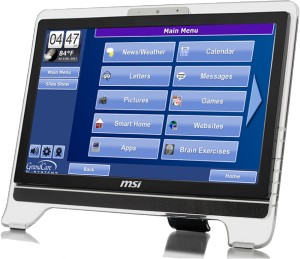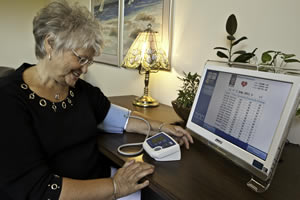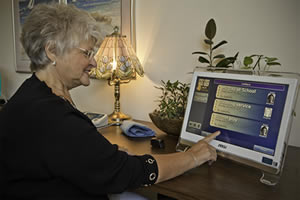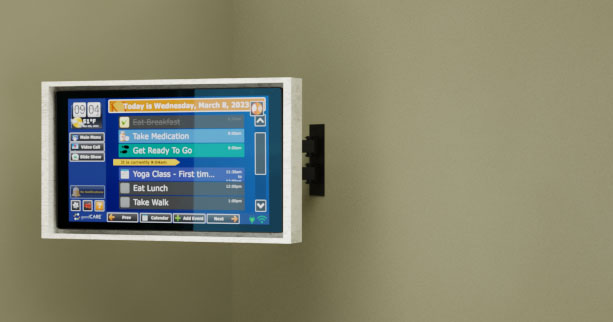Chronic disease is society’s biggest health-care challenge. Even if we do a good job preventing disease by helping people live healthier lives, it’s inevitable that for at least the foreseeable future, conditions like heart disease, diabetes, and depression will be our society’s most substantial health-related issues. The term “chronic” is used to describe conditions that are long lasting, so it shouldn’t come as any surprise that they are incredibly expensive, both financially and in terms of quality of life. (See the chronic diseases in America and Department of Health & Human Services for some striking statistics.)We must design home-care tech that integrates into people’s lives.
A big change to the way we help people live with these conditions could go a long way toward improving the effectiveness of our health-care system, reducing costs and improving access for everyone. And fortunately, not only is this a public-health opportunity but a huge opening to make a difference in people’s lives — to get their attentions before disease gets out of control, which is when things get both unpleasant and costly. For many, the diagnosis of a chronic condition is scary, but it also brings their health into focus for the first time in their lives. In this moment, people may be receptive to dramatic interventions and be motivated to focus on their health.
Chronic-disease care happens where people live their lives. Patients with diseases like heart disease or diabetes typically visit a hospital or doctor’s office relatively infrequently (usually between once a month and once a year). The real care related to these conditions actually happens every day in people’s homes and workplaces, and is often delivered by “patients” themselves and their loved ones. We have to challenge ourselves to design home-care technology to better integrate into people’s lives.
Nurses, doctors, and other professionals are hugely important to any real improvements to chronic care, but they aren’t always around. Technology can help fill the gaps, possibly in a way that may even help an individual feel more like an empowered person, less like a helpless patient. There’s growing momentum around the idea that the consumer electronics of the future must not only entertain us when we’re on the couch but also help us get off the couch, and not only keep us connected with each other but also with ourselves and our bodies.
There’s a world of opportunity for the connected home to better support people who are managing chronic disease. While there’s a lot of diversity in the conditions that fall under the heading of “chronic,” from cancer to depression, and there are clearly no one-size-fits-all solutions, there are some common things a home-care ecosystem should provide.
Strategies for managing chronic disease
Managing a chronic disease almost always requires substantial changes in a person’s behavior; they often must replace habits that led to the disease (like eating lots of sugar or smoking) with new habits (like eating veggies or exercising) and almost always must establish new routines around their care regimen (like weighing themselves, testing blood-sugar levels and giving themselves a shot). The same enablers of behavior change for prevention I discussed in my last post apply here: health and behavior data tracking, assessments and feedback from the data, goal-setting and progress tracking, gentle nudges, and the involvement of social networks.
But there are some new considerations here. Because it’s necessary for interventions to be higher impact and have more immediate results, these enablers should present a different face than for a well person who’s trying to lose a couple of pounds and get their blood pressure down a bit. And there are new needs — while all people would be well-served by better ways to communicate and collaborate with their doctors and nurses, a person with several serious conditions may be coordinating the efforts of a pretty large care team, which right now requires countless hours of phone calls, faxing, photocopying, and (for lack of a better term) project management.
The activated patient
The Wegner Chronic Care Model is a good starting place for talking about how to improve chronic care. Much of current medical thinking on chronic-disease management is framed by the ideas developed by Dr. Ed Wegner and others at the MacColl Institute for Healthcare Innovation. This model talks about how patients, practice teams, communities, and health systems can come together to improve things like care coordination, adherence to best practices, and patient education and empowerment. (Here’s a goodvideo of the Wegner explaining the model and the thinking behind it.)
How do we motivate people to take charge of their own health?
But implementation of the Wegner Model has largely been very institution-oriented. While the application of this model has already shown some very positive results, unsurprisingly much of the work that has been done has come from the institutional side — changes to clinical workflow and the way clinicians interact with patients. This is great and very welcome, but when we talk about creating “informed, activated patients,” I believe there are some underutilized ways technology can help patients activate themselves and one another.
This brings me to the big question: How do we motivate and enable people to take responsibility for their own health and health care? It’s really common for us to be very good at caring for our friends and families, not to mention our homes, cars, and jobs, but we don’t always take the same level of care with our own minds and bodies. The trend in consumer electronics toward more personal experiences on tablets, smartphones, and even television is a perfect wave to catch with the idea of self-care.
I really like the ideas put forth by the Washington Health Foundation around “people-centered health.” Among other things, they take a bit of a rebellious stance and promote the radical idea that people must be empowered to be “partners in their health,” and that the current medical system (and a lot of supposedly “patient-centered design”) discourages individuals from solving their own problems by treating them as “patients.” They propose a number of very interesting design principles that are meant to help create services that actually put people in control of their own health care.
I’d like to add something to those tenets: “Good person-centered health design creates an emotional tone that is conducive to self-care.” What I mean by that is in order to effectively reduce the impact of chronic disease, we have to encourage people to establish sustainable, healthy ways of life for themselves, rather than being “treated” by nurses and doctors. Emotional tone is key because this is how exercise and healthy food become sources of joy, rather than unpleasant chores, and a treatment regimen becomes the enabler of good living, rather than yet another indignity. To create this tone, we must bring the same level of design craft and attention to home-health-care experiences as we do to the best housewares and consumer electronics.
Read more





 The GrandCare system was the first system to combine socialization, activities of daily living (ADLs) and telehealth monitoring, which together provide peace of mind for family members living close by or long distance. With “wireless” Bluetooth, X10 and ZWave sensors throughout the home, family and caregivers can monitor the senior’s health and home. No computer skills are needed to operate the easy to use senior home care solution that features an interactive touch screen. Designated caregivers and family can log into the GrandCare website and access sensor graphs, vitals and set up parameters/rules to receive alerts if specific events occur such as medications are not taken, a door is opened at odd times, a refrigerator is not accessed at meal time or an individual did not get out of bed.
The GrandCare system was the first system to combine socialization, activities of daily living (ADLs) and telehealth monitoring, which together provide peace of mind for family members living close by or long distance. With “wireless” Bluetooth, X10 and ZWave sensors throughout the home, family and caregivers can monitor the senior’s health and home. No computer skills are needed to operate the easy to use senior home care solution that features an interactive touch screen. Designated caregivers and family can log into the GrandCare website and access sensor graphs, vitals and set up parameters/rules to receive alerts if specific events occur such as medications are not taken, a door is opened at odd times, a refrigerator is not accessed at meal time or an individual did not get out of bed.







